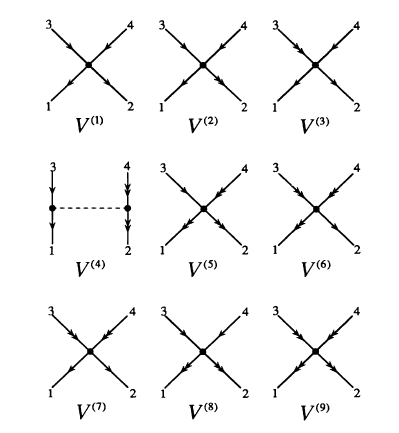I am confused about the Feynman diagrams of spin Hamiltonian, for example, the Heisenberg model, the quartic terms like this $[1]$: \begin{align} V &= -\frac{z}{4}\frac{J}{N}\sum_{1,2,3,4}\delta_{G}(1+2-3-4)\left[ V^{(1)}_{(1234)}\alpha^{\dagger}_{1}\alpha^{\dagger}_{2}\alpha_{3}\alpha_{4} +V^{(2)}_{(1234)}\alpha^{\dagger}_{1}\beta_{2}\alpha_{3}\alpha_{4}+V^{(3)}_{(1234)}\alpha^{\dagger}_{1}\alpha^{\dagger}_{2}\beta_{3}^{\dagger}\alpha_{4} \right. \\ & \qquad\qquad\qquad \left. +V^{(4)}_{(1234)}\alpha^{\dagger}_{1}\alpha_{3}\beta^{\dagger}_{4}\beta_{2} +V^{(5)}_{(1234)}\beta_{4}^{\dagger}\alpha_{3}\beta_{2}\beta_{1}+V^{(6)}_{(1234)}\beta^{\dagger}_{4}\beta^{\dagger}_{3}\alpha_{2}^{\dagger}\beta_{1} +V^{(7)}_{(1234)}\alpha^{\dagger}_{1}\alpha^{\dagger}_{2}\beta^{\dagger}_{3}\beta^{\dagger}_{4} \right. \\ & \qquad\qquad\qquad \left. +V^{(8)}_{(1234)}\beta_{1}\beta_{2}\alpha_{3}\alpha_{4} +V^{(9)}_{(1234)}\beta^{\dagger}_{4}\beta^{\dagger}_{3}\beta_{2}\beta_{1} \right] \end{align}
$\alpha$,$\beta$ for magnon operators, the feynman diagrams for these vertices are$[1]$:
single arrow for $\alpha$ magnon, double arrow for $\beta$ magnon.
Most of the vertices are represented by a solid circle, is this just a convention? Can I draw them all as $V^{(4)}$ ? In many body physics textbook , the two body interaction vertices are represented by a dashed line with 2-in and 2-out legs.
I have read A.L.Fetter and J.D.Walecka's, Quantum theory of many-particle systems and W.H.Dickhoff and D.van Neck's Many body theory exposed, but I can't find any many body textbook introduce Feynman diagrams of spin Hamiltonian. Although in many cases we rewrite the spin Hamiltonian as boson Hamiltonian, they are also different from boson perturbation introduced in many body textbook (BEC).
- Theory of Raman scattering in layered cuprate materials. C. M. Canali and S. M. Girvin. Phys. Rev. B 45, 7127 (1992).



